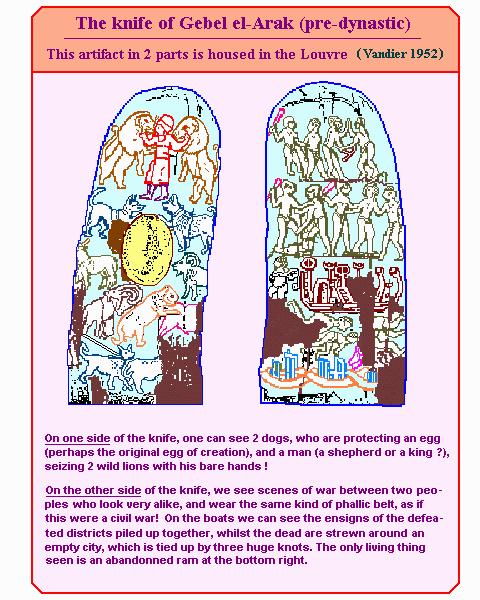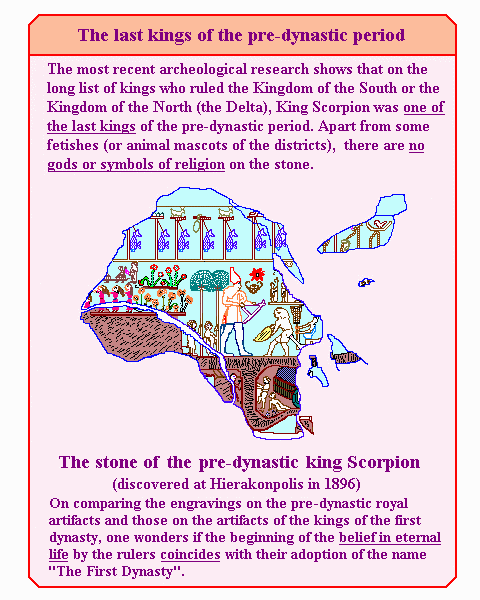
| Egypt during the Archaic and Pre-dynastic Periods |
The small Egyptian states were regrouped at around 5.000BC into two large kingdoms: one being the Kingdom of the Delta, which celebrated the god Horus (the ancient); and the other the Kingdom of the Valley of Nile, which worshipped Kom Ombo, and at Hierakonpolis, the god Set. But during the IVth millenium BC., the Kingdom of the North took over the South, Horus ousted Set, and the pre-dynastic Pharaohs reigned over a united Egypt.
The years 4 500BC to 3 300BC are called the Magdalean, which corresponds to the "three ages of the Pre-dynastic period " of Egypt:
| Ancient (4500 to 4000BC), Middle (4000 to 3500BC), and Recent (3500 to 3300BC) |
We shall only concern ourselves briefly with these three ages : since except for some potteries, some frescos of hunting and of wars between the cities or mini-kingdoms of the Nile, the head of a knife and the "Stone of Palerme" (on which many drawings are missing), the information we gain from them of Neolithic culture is sparse and doesn't describe their daily life or their spiritual concerns.
The
main zones of political
influence
during |
|
However on parts of the so-called "Stone of Palerme", the scientists have counted at least "twenty five kings", who already had ruled in the two kingdoms of Upper and Lower Egypt before the advent of the first royal official dynasty.
The paintings in tomb N°100 of Hierakonpolis, like those on the knife of Gebel el Arak, show pictures of boats without sails or oars, some of lions, of dogs, and especially of wars between two peoples of identical appearance (except for their styles of hairdressing). This doesn't bring much information on the mystical part of Egyptian life or of their belief in a new life after death on this earth...
The main divinities honored in the ancient period
The " main divinities" in the ancient popular cults and on the royal weapons of the times, are :

EGYPT during the dynastic period : 3 500 to 3 300BC
According to the "Stone of de Palerme," there were ten Pharaohs who had already ruled over a united Egypt, before the FIRST Official DYNASTY, (and there were as many precursors to them), they wore the two crowns of royalty :
Around the year 3 500BC, there was a new schism : the king of North, called Biti, (in hieroglyphics, bee), protected by the cobra goddess Ouadjet, took the red crown and moved to Bouto. Thus the king of South, Nesout, (which means the reed), protected by the vulture goddess Nekbet of El-Kab, took the white crown and moved to Hierakonpolis.
Bouto became the political capital of the Delta, and Letopolis became the religious capital of the North; this city the Greeks later gave the name of Heliopolis.
Here in order are the seven Pharaohs who reigned during dynasty zero, classified in 1982 by the Egyptologist Kaiser-Dreyer:
Names of the Pharaohs
of "dynasty
zero" who reigned
|
|
The chronology of these first kings is very difficult to state definitely. These dates are the object of numerous debates fueled by a lack of irrefutable evidence. Did King Narmer (3185 to 3125BC) directly succeed the king Scorpion, as some scolars want us to believe ? Was it because of the inauguration of the State religion that Narmer was classified as the first king of the first dynasty ? (Several kings before him had also ruled over a united Egypt)
Why does the club of king Scorpion have no sacred mention, when that of king Narmer shows him seated on his throne before a god (which is a human silhouette without a face, like a MUMMY), maybe SOKAR or PTAH ?
It is possible that some precursors of the kingdom of Imhotep already visited the court of Egypt and began religious instruction of the king 400 years before Imhotep ! But the multitude of ancient Egyptian gods may have prevented the acceptance of the new concepts imposed by Imhotep.
According to the archaeological evidence at our disposal, we find probably at this period that the gods and goddesses took on in the Egyptian mind a HUMAN appearance, without relinquishing the myriad of composite divinities : mid human, mid animal.
This summary of the pre-dynastic era is needed to understand the incredible reforms which at that time transformed the culture, religion and civilization of the first country in the world to discover (long before the Bible was written and before the birth of the Patriarchs), the existence of The ONE Invisible GOD.
Religious spirit grew thanks to the influence of Pharaoh Djeser, who without destroying the former divinities, gradually decreased their importance and offered the country a new concept of religion, 700 years before the message of Abraham.
In fact, the Pharaoh retained the beautiful Sarah in his harem, and Abraham frequented the royal court ?
One can also summarize and compare this new religion to the Ten Commandments given by Moses to the Hebrews!
Also, was not Moses the adopted son of Pharaoh ? His education must have been planned by the Egyptian priests, holders of the wisdom of their predecessors ?
There is a strange resemblance between the codes of life and the written wisdom of the kings and ministers of the VIth dynasty and the civil and religious code of Moses given orally a thousand years later !
Why did God want the Hebrew people to stay in Egypt and become an example of life and a spiritual model which would subsequently inspire numerous religions ?
The history of religious life in Egypt had many declines (especially in the New Kingdom), where many kings, forgetting the rules and laws of their ancestors, grew arrogant, and constructed huge statues and palaces in the heart of the forbidden necropoles ! Then they required that the people worship them as ALL POWERFUL beings. But God has many ways of working, and He was to choose other people to teach humanity about Him.
The message of the Eternal being perpetual, a lot of people would be given the mission of spiritually leading humankind, and in Egypt two men (comparable to the two Hebrew prophets Moses and Elijah) stand out thanks to their intelligence and knowledge: the first was called IMHOTEP - the vizier of king Djeser, and the second : AMENHOTEP (son of Hapou) the architect and the physician of Amenophis III.
Egyptian drawings of pre-dynastic times
The knife of Gebel el-Arak of Hierakonpolis (Vandier 1952)

The handle of this knife, on show in the Louvre shows us some scenes of hunting and war. Who is the Pharaoh who is holding two lions with his naked hands ? Has this something to do with the primordial egg guarded by the dog god SETH ? Just as the message carved on the club of the Scorpion king shows us " the absence of the great divinity ". However, on the other side of the knife we see scenes of war on the banks of the Nile and a city bound like a prisoner, above which floats some bodies who look insentient.
The knife of Gebel el-Arak belonged to a Pharaoh of Upper Egypt who probably lived around 3 500BC., and like the tablets made of stone, are decorated with the symbols of the god Min of fertility, or with some precursors of the goddess Hathor. Most these artifacts have been found in tombs beside the bones of the dead. Their presence attests therefore that their was some belief in rebirth in the western Protodynastic era, continuing the customs of Neanderthal man (150 000BC to 35 000BC), who buried their dead with their favorite weapons and some supplies (!) for his long journey into the unknown world !

The club of the pre-DYNASTIC king SCORPION (Vandier 1952)

The fragments of this club, which goes back to 3 300 BC, represent four scenes from the life of the pre-DYNASTIC royal Egyptians :
In the upper part a parade of figurines who were mascots of the various districts of Upper Egypt brandish a stick on which is a big fish hanging by the tail. This probably alludes to a victory of king Scorpion over the kingdom of fishers of the Delta.
On the left of the central part a slave threatens a bound captive with his stick , while beside him some Egyptian women, (maybe those belonging to the harem of the Pharaoh) braid their hair with large flowers of a stylized lotus. At the center, king Scorpion (identified by his emblem), crowned with the white mitre of Upper Egypt and holding a hoe, receives from one of his subjects a tray of grains symbolizing the harvest, and the peasant has a goose whose neck is at the same level. Behind them there is a second person carrying a vase of grapes or fruit.
In the lower part of the club one can see a man climbing a wall while his kneeling companion carries on his head a large wooden jar surmounted by a huge bee, (the symbol of the defeated Lower Egypt.) Even though it is incomplete, this pre-dynastic tableau shows us the life and the (lack of a belief system, as shown on the royal weapons of king SCORPION). This indicates that religion had very little importance at that time.
o - o - o - o - o - o - o